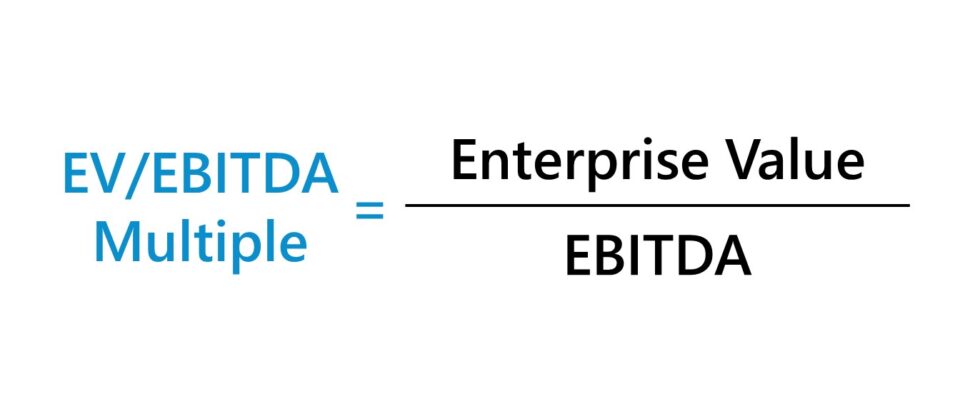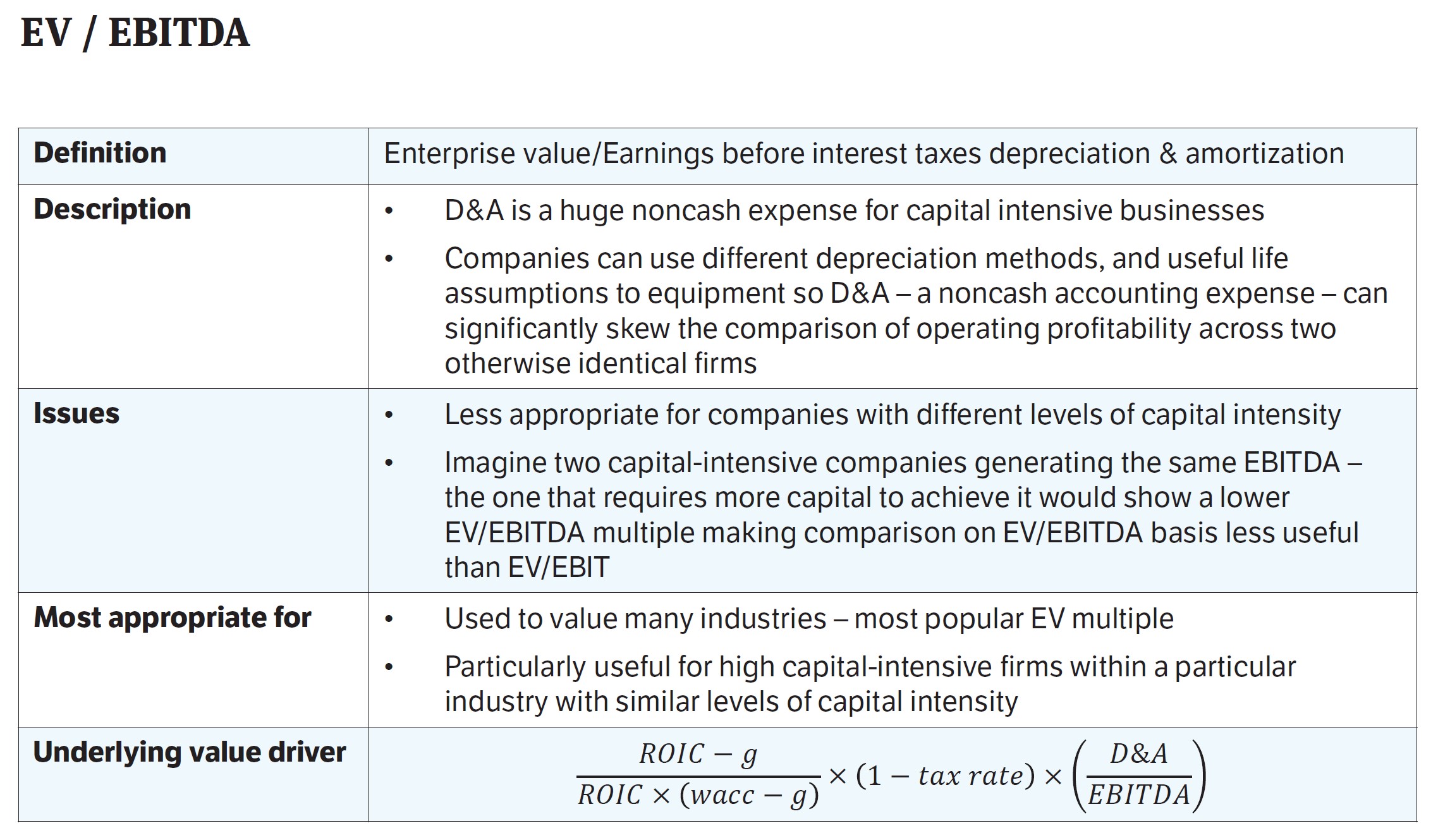EV/EBITDA Multiple
Mục Lục
What is EV/EBITDA?
The EV/EBITDA Multiple compares the total value of a company’s operations (EV) relative to its earnings before interest, taxes, depreciation, and amortization (EBITDA).
In practice, the EV/EBITDA multiple is frequently used in relative valuation to compare different companies in the same (or similar) sector.

How to Calculate EV/EBITDA Multiple (Step-by-Step)
The enterprise value represents the debt-inclusive value of a company’s operations (i.e. unlevered) while EBITDA is also a capital structure neutral cash flow metric.
Conceptually, the EV/EBITDA multiple answers the question, “For each dollar of EBITDA generated by a company, how much are investors currently willing to pay?”
- Enterprise Value (EV): The numerator, the enterprise value, calculates the value of a company’s operations, i.e. how much the company’s operations are worth from the perspective of all stakeholders, such as debt lenders and common shareholders.
- EBITDA: EBITDA stands for “earnings before interest, taxes, depreciation, and amortization”, and is a widely used proxy for a company’s core operating cash flows (i.e. unlevered).
Learn More → Enterprise Value Quick Primer
The EV/EBITDA multiple, or “enterprise value to EBITDA”, is thus widely used to benchmark companies of varying degrees of financial leverage.
- Enterprise Value Multiple: Since EV/EBITDA is categorized as an enterprise value multiple, ensure that the numerator and denominator represent the same investor groups – which in this case, is all investor groups (e.g. common and preferred equity shareholders, debt lenders). In other words, the cash flows must pertain to all providers of capital. For example, interest expense must NOT be deducted from the cash flow metric used here, as it is specific to one investor group, the lenders.
- Equity Value Multiple: Unlike a levered valuation multiple such as the price to earnings ratio (P/E ratio), the EV/EBITDA multiple accounts for the debt sitting on a company’s balance sheet. Therefore, the EV/EBITDA multiple is frequently used to value potential acquisition targets in M&A because it quantifies the amount of debt that the acquirer must assume (i.e. cash-free, debt-free).
If there are two virtually identical companies with their leverage ratios consisting of the sole difference (i.e. percentage of debt in the total capitalization), you’d expect the two EV/EBITDA multiples to be similar.
While these two companies are very unlikely to actually be the same, in theory, the enterprise value and EBITDA metrics are each independent of capital structure decisions, and thus it makes sense that they would have similar EV/EBITDA multiples.
The process of calculating the EV/EBITDA multiple can be broken into three steps:
- Step 1. Calculate Enterprise Value (Equity Value + Net Debt)
- Step 2. Calculate EBITDA (EBIT + D&A)
- Step 3. Divide Enterprise Value (EV) by EBITDA
Learn More → EBITDA Quick Primer
EV/EBITDA Formula
The formula for calculating the EV/EBITDA multiple is as follows.
EV/EBITDA = Enterprise Value ÷ EBITDA
At their simplest, the two metrics can be calculated using the following formulas:
Enterprise Value (EV) = Equity Value + Net Debt
EBITDA = EBIT + Depreciation + Amortization
EV to EBITDA Multiple: Definition, Interpretation and Issues

EV/EBITDA Commentary Slide (Source: WSP Trading Comps Course)
Learn More → Valuation Multiple
What is a Good EV/EBITDA? (High or Low)
Generally, the lower the EV to EBITDA ratio, the more attractive the company may be as a potential investment.
- Low EV to EBITDA Ratio: Potentially Undervalued by Market
- High EV to EBITDA Ratio: Potentially Overvalued by Market
However, there are no set rules on what determines a low or high EV/EBITDA valuation multiple because the answer is contingent on the industry that the target company (i.e. the business being valued) operates within.
For example, an EV/EBITDA multiple of 10.0x could be viewed as being on the higher end for a consumer goods company. However, a software company valued at 10.0x may even be on the lower end of the valuation range commonly found in the software industry.
Therefore, interpretations of valuation multiples are all relative and require more in-depth analyses before making a subjective decision on whether a company is undervalued, fairly valued, or overvalued.
Additionally, for that reason, comparisons of a company’s EV to EBITDA multiple should only be made among companies that share similar characteristics and operate in similar industries.
Learn More → Enterprise Value Multiples by Sector (Source: NYU, Damodaran)
Enterprise Value to EBITDA Multiple: Pros and Cons
For the most part, much of the criticism surrounding the usage of the EV/EBITDA multiple is around the EBITDA metric.
To many industry practitioners, EBITDA is not an accurate representation of a company’s true cash flow profile and can be misleading at times, especially for companies that are highly capital intensive.
EBITDA Pros
EBITDA Cons
- Convenient to Calculate and Widely Used by Industry Practitioners (e.g. Equity Research Reports, Financial News)
- Criticized for Being an Inaccurate Proxy for Operating Cash Flow
- Adds-Back Non-Cash Expenses – e.g. Depreciation & Amortization (D&A)
- Despite the D&A Add-Back – Remains Prone to Accrual Accounting and Management Discretion
- Most Appropriate for Mature Companies Late in their Lifecycle with Minimal Capital Expenditures (Capex)
- Less Appropriate for Capital Intensive Industries (i.e. Does NOT Account for Capital Expenditures)
In certain scenarios, adjusted valuation multiples such as EV/(EBITDA – Capex) can be used instead, which is oftentimes seen in industries like the telecom industry where there is the need to account for capital expenditures due to the sheer degree of impact that CapEx has on the cash flows of companies in these types of industries.
Seth Klarman Commentary on EBITDA (Source: Margin of Safety)
There is also much debate regarding the topic of “adjusted” EBITDA about whether certain line items should be added back or not.
One notable example would be stock-based compensation (SBC), as certain people view it as a straightforward non-cash add back, whereas others focus more on the net dilutive impact it has.
But regardless of its shortcomings as a measure of profitability, EBITDA still removes the impact of non-cash expenses (e.g. depreciation and amortization) and remains one of the most commonly used proxies for operating cash flow.
















![Toni Kroos là ai? [ sự thật về tiểu sử đầy đủ Toni Kroos ]](https://evbn.org/wp-content/uploads/New-Project-6635-1671934592.jpg)


